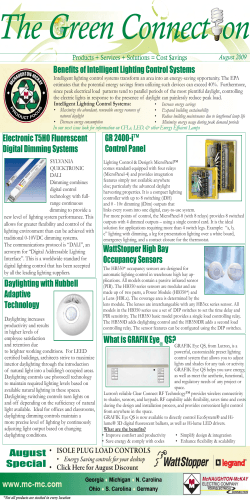
How to use Dialux?
How to use Dialux? What is it? • DIALux is continuously being developed by a team of 20. You can plan in DIALux with the luminaires of the world's leading manufacturers and therefore have the greatest possible freedom in the design process. And the the list of international partner companies is getting longer and longer. Your benefits at a glance: • • • • • Simple, effective and professional light planning Latest luminaire data of the world's leading manufacturers Latest state of the art software always available free of charge Energy evaluation at the drop of a hat Coloured light scenes with LED or other colour changing luminaires • Planing whole buildings including outdoors spaces* Flow chart for light planning 1. Analysis of the planning objective • Define the activities and different visual work that may be performed in the premises at different times of the day. • Define the lighting demands with regard to safety, visual needs and the visual experience. • Examine the need for emergency lighting. Define the aims for energy consumption, environment and maintenance of the lighting installation. 2. Analysis of planning conditions • Define applicable provisions, standards, recommendations as well as special demands from the client and users. • Define the conditions for lighting the room, the type of workplace and its working area, etc. • Investigate the conditions for the premises’ design, furnishings, type of monitors, flexibility, daylight and the character of the premises. • Establish the economic prerequisites for the installation and the maintenance conditions for the lighting installation. 3. Overall planning • Investigate the conditions for interaction between electric light and natural daylight. Check the possibility of daylight screening. • Investigate which light sources, luminaires and lighting systems best satisfy the demands aims and conditions. • Investigate the control possibilities for the lighting to increase comfort and improve energy usage. • Investigate the overall co-ordination with other installations, colour setting and furnishings. 4. Detailed planning • Evaluate the different lighting systems; technically, visually and economically. • Establish the lighting system’s optimal maintenance factors taking the maintenance conditions into consideration. • Make a financial evaluation by calculating the life cycle costs based on the investment, operation and maintenance. • Compare the selected lighting systems with regard to other installations, colour setting, furnishings and the chosen equipment. 5. Documentation • Should be prepared as shown below with supplements according to the client’s wishes. • Include Installation drawings, control and assembly instructions as well as associated lists of light sources and luminaires. • Lighting calculations and visualisations that verify under which conditions the system operates to the specified demands. Present calculation prerequisites and the lighting system’s maintenance plan. • Present calculation prerequisites and the lighting system’s maintenance plan. New project New interior project New exterior project New street project Toolbar Set up the dimensions • Room editor - Change dimension Set up the room properties Set up the room properties • Name • Material • Texture Data base • Downloded catalogues • Online catalogues Luminaire, mountig, arrangement Calculating and results Summary How to interpret the standard output generated by DIALux • Quantities, units and their significance •Quantities, units and their significance General advice • The following points should be considered in order to create low energy usage in a lighting installation: • selection of light sources with optimal luminous efficacy for the required colour reproduction. • energy efficient lighting system with installed lighting output suitable for the required task. • efficient luminaires with the correct light distribution and good cut-off properties. • efficient utilisation of daylight. • efficient utilisation of artificial and natural light through the selection of a light interior colour scheme. • control of lighting through presence detection. • possibility of localised control by the individual. • high frequency operation with dimming. • well planned maintenance of the lighting installation to obtain a high maintenance factor. Workplace lighting • The values stated in the collection of tables, refer to the lowest illuminances in the workspace of a visual object, that can be either horizontal, vertical or placed at an angle. • The demands on illuminances used in the workplace, should be regularly reviewed to overcome the following situations: • difficult working conditions • activities that demand great accuracy or high productivity • impairment of visual efficiency • viewing objects with fine detail or in low contrasts of light • using DSE terminals for long periods of time Principles for establishing the working area and surrounding calculation surfaces Glare • Glare can be divided into: • Disability glare • Discomfort glare • Calculation of the glare index The degree of discomfort glare for indoor installations can be estimated by calculating the glare index according to the UGR method. The UGR glare index for discomfort glare is ranked on a scale, which in practice runs from 13 to 28 where the higher the glare index the higher the level of glare. The smallest change in the glare index denoting a significant difference is 3. • Reflections from reflective materials or reflective glare can usually be prevented with the following actions: • Suitable luminaire positioning. • Selecting luminaires with low luminous intensity and effective screening. • Selecting matt materials for reflective surfaces. • Selecting luminaires with a larger surface area. • Select light colours for ceilings and walls. Luminance distribution and luminance limitations • A well-balanced luminance for adaption is essential to increase: • The visual clarity. • Contrast sensitivity (ability to detect small differences in luminance). • The effectiveness of the eye’s ocular functions (e.g. accommodation, convergence, pupillary contraction, eye movements, etc.). • The following should be avoided: • High luminances that can cause glare. • Large luminance contrasts that cause visual tiredness where the eye tries to continuously adapt. • Low luminance contrasts, which result in a staid atmosphere that does not stimulate. Visual evaluation of lighting systems in work areas Light distribution curve Combined diagram for spotlights Isolux diagram Interpretation of the calculation result. 1. Scrutinize carefully • To prevent glare - check the luminance conditions in the room. 2. Maintenance factor • Has the maintenance factor been adapted to a maintenance plan for the lighting installation? • NOTE - the maintenance factor affects the lighting system’s energy consumption. 3. Calculation conditions • Have the conditions for the lighting calculations been checked? • Has the size of the working area and immediate surroundings been established? • Has the calculation area for the peripheral area been defined? • Have the room surfaces’ reflectance values been checked? • Has the luminaire’s average luminance been checked in rooms used for monitor work? 4. Uniformity demands. • When calculating the illuminance uniformity i.e. the ratio between the minimum value and the average value in the working area and the immediate surroundings, it is important that the distance between the calculation points is documented. For normal working areas a maximum spacing of 0.25 metres between calculation points applies. 5. Graduation implication • Use the scales for illuminances and luminances stated in the standard EN 12464-1. 6. UGR-glare index. • Check, where appropriate, that the system’s average glare index conforms to the value stated in the standard. Bibliography • Lighting planning • http://www.fagerhult.sk/products/technicalinfo/documents/FAGERHULT_belysningsplanering _UK.pdf • Dialux basic tutorial: • http://www.youtube.com/watch?v=oOITu-qMk6A
© Copyright 2025





















